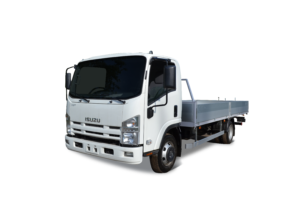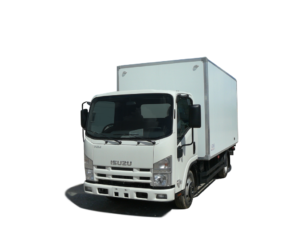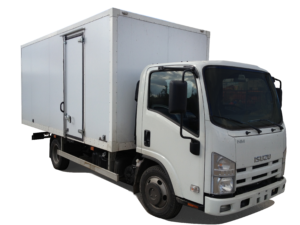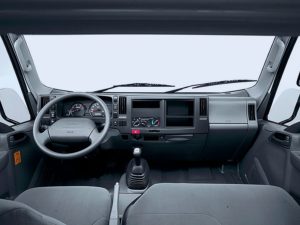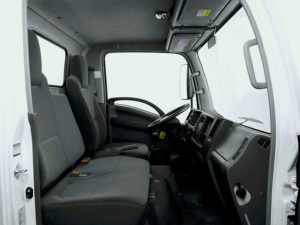Isuzu Elf — Wikipedia
| Isuzu Elf / Isuzu N series | |
|---|---|
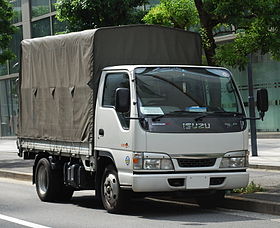 | |
| Overview | |
| Manufacturer | Isuzu |
| Also called |
|
| Production | 1959–present |
| Assembly |
|
| Body and chassis | |
| Class | Truck |
| Body style | Truck (standard cab, crew cab) |
| Platform | Toyota Dyna (China) |
| Related |
|
The Isuzu Elf (Japanese: いすゞ・エルフ, Isuzu Erufu) is a medium duty truck produced by Isuzu since 1959. Outside Japan it is known as N series. The range was originally mainly available in Japan and other Asian countries. Australia was another important market for the Elf and N series – to the extent that it was manufactured there from the 1970s using many local components. Since the early 1980s, it has also been sold and built in the United States (under the Chevrolet and GMC brand as a W series), and also as the Isuzu N series. North America only receives the wide-cab version.
For the common Andinian market (including Chile and Peru), the truck has been assembled in the GM-Colmotores assembling plant in Bogotá, Colombia since 1991, with annual quantities already of 20,000 up to 60,000 units. Local assembly has been increasing because of increasing demand in the Colombian and neighboring markets. It carries «Tecnología Isuzu» (with Isuzu Technology) lettering.
In Indonesia, Philippines and several other countries, the Elf is not only used as trucks, but also converted into microbuses by local body makers. The lighter four-wheeled models are commonly used as an intercity Angkot (share taxi), as a school bus, or as an employee bus.
First generation[edit]
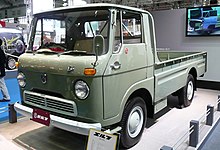 Isuzu Elf first generation (1959-1965 model)
Isuzu Elf first generation (1959-1965 model)The cab-over 2-tonne (4,400 lb) Elf (TL221) was originally introduced in August 1959. It was originally only available with the 1.5 litres (1,491 cc) GL150 petrol engine with 60 PS (44 kW). [5] It had single headlights and rear-hinged doors. A longer wheelbase version, on 2,460 mm (97 in) versus the 2,180 mm (86 in) of the regular version, was also available. This carries the TL251 chassis code.[6]
In March 1960 a 2-liter diesel engine with 52 PS (38 kW) was introduced (TL121/151), a first for the class in Japan — this was soon followed by diesel models from Isuzu’s competitors. In 1962 the engines were updated, and now have 72 and 55 PS (53 and 40 kW) respectively. The chassis codes were changed to TL321/351 for the diesel version, reflecting the installation of the all new DL201 engine.[7] A little later, the chassis codes were reorganized and were now TLG10/11 for the petrol models and TLD10/11 for the diesels. In 1964 the long wheelbase model became the standard version.[8] In 1964 the diesel was also upgraded to the larger 2.2-litre C220 with 62 PS (46 kW).
Isuzu ended up offering a very wide variety of bodyworks for the first Elf. There was the original integrated bed, as well as a separate truckbed with dropsides. There was a double-cab version available, as well as special bodywork for dedicated purposes such as a soda truck, a dumper, and a tanker. There was also a «Route Van» model with a glazed rear compartment and seating either three or six, as well as the «Elf Bus» which was available in two models from 1960.[10] The Elf Light Bus has integrated bodywork and the long wheelbase and seats 21 passengers (chassis codes BL171/271 for the diesel/petrol) while the Elf Micro Bus fit into the very narrow slot between the Route Van and the Light Bus. The Micro Bus originally had the Route Van’s bodywork but was more passenger oriented (seating 12 or 15). It carried the TL121/151/21/251B chassis codes, and from 1961 it received its own rear bodywork with bigger glazing. [11] The Elf Bus later became its own line, called the Isuzu Journey.
Second generation[edit]
1967-1970 Isuzu Elf (KA40)In August 1967 the all-new «Isuzu Light Elf» was added to the existing lineup; this lighter duty version was rated for a 1.25-tonne payload (2,800 lb).[12][13] It had single round headlights and a KA-series chassis code; it came with the same 1471 cc G150 engine as fitted to period Isuzu Belletts, providing 68 PS (50 kW). This was the first of the second generation Elfs to be introduced, heavier duty models soon followed and replaced first generation variants.[12]
In April 1968 the second generation Elf appeared (TL21/TLD21 series). A walk-through van («Elf Hi-Roof») was also introduced, another first for Japan. In September 1969 the «Light Elf» was upgraded to 1.5-tonne (3,300 lb) and now offered a more powerful 1.6-liter engine (G161AB) with 75 PS (55 kW).[12]
The heavier duty Elf 350 was not immediately replaced but continued in production until the 1980 model year, when in February a 350 model of the third generation Elf was introduced («350 Wide»).
Third generation[edit]
Third generation Elf 250 Super, second facelift (1981-1984) The third generation Elf arrived in June 1975, in Elf 150 and 250 forms. It was nicknamed «Tora-san» after Kiyoshi Atsumi’s (a famous Japanese actor) most beloved film character which supposedly looked similar.[14] In January 1977 a 250 Low-Flat model was added, followed in 1978 by a facelift and an altered front grille. In 1979 a bigger 3.3-liter version of the 2-tonne (4,400 lb) Elf 250 was introduced, called the «Elf 250 Super». There was also a «Elf 150 Super» version, which has the larger, 2.4-liter C240 diesel engine which was usually installed in the Elf 250.[15] In 1978 Isuzu also sold their millionth Elf.[14] In January 1980 the Elf was updated to meet Japan’s 1979 emissions standards, which was also when the design was changed to accommodate a tilting cab. The Elf 250 Wide and 350 Wide were added, with KT and KS chassis codes respectively, meaning that the second generation Elf 350 could finally be retired. The Elf Wide has a cabin 1,910 mm (75 in) wide, rather than the 1,690 mm (67 in) cabin used in the TL and KA series Elfs.In 1981 the Elf range underwent another facelift, with an updated dashboard as well. For the third generation Elf the diesel engines had been modernized for more ease of operation, while the world’s then smallest direct injection diesel engine — the 3.3-liter 4BC2 — was also introduced.[14] It arrived in 1982 and replaced the less powerful 4BC1 which had appeared in 1979. In March 1983 the diesel engines were again modified, reflecting new Japanese emissions standards for commercial vehicles. While the third generation Elf was mostly replaced in 1984, the «Route Van» (three- or six-seater van version) continued in production until the early 1990s. With the same bodywork there was also a more habitable bus version available; this was marketed as the Isuzu Journey S and was built on Elf 150 basis (KAD51ZB).[15]
| code | engine | output | models | |||
|---|---|---|---|---|---|---|
| PS | kW | at (rpm) | ||||
| KA41/51 | G161, petrol I4 | 1584 cc | 84 | 62 | 5200 | Elf 150 |
| KAD41/51 | C190, diesel I4 | 1951 cc | 62 | 46 | 4400 | Elf 150, Journey S |
| KAD42/52, TLD23 | C240, diesel I4 | 2369 cc | 74 | 54 | 3800 | Elf 150 Super, Elf 250 |
| TLD24/34/44/54/64 | 4BA1, diesel I4 | 2775 cc | 85 | 63 | 4000 | Elf 250 |
| TLD55 | 4BC1, diesel I4 | 3268 cc | 95 | 70 | 3500 | Elf 250 Super |
| TLD26/36/46/56, KT16/26/36/46 | 4BC2, DI diesel I4 | 100 | 74 | 3500 | Elf 250 Super, Elf 250 Wide | |
| KS | 4BD1, diesel I4 | 3856 cc | 110 | 81 | ??00 | Elf 350 Wide |
Fourth generation[edit]
1990-1993 Isuzu Elf 250 Wide double-cabThe fourth generation Elf range appeared in July 1984. This Elf was exported widely across the world and manufactured in several different countries, including the United States. It was sold as the Chevrolet Tiltmaster, and also as the GMC Forward. GMC’s Forward replaced their L series and has a 165 hp (123 kW) turbodiesel straight-six engine.[17] It was also the first model to use the long-running Isuzu N-series label. In 1986 a heavier duty 220 hp (164 kW) 8.4-litre diesel version of the Forward was added to the US market.[18]
In Japan this generation was only offered with direct injection diesel engines, introducing the new 2.8-liter 87ps 4JB1 family industrial version with dual mode transmission depending in application.and the 3.6-liter 4BE1 direct injection engine for the Elf 250 and Elf 350 NPR. which replaced the long running 4ba1 as the standard Elf 150 10 ft. And Elf 150 14 ft. 6 wheel.[14] In September 1987 a 16 ft. heavier version Elf 350 wide has arrived. With The long stroke direct injection with dual mode manual transmission 3.9-liter 4BD1 and 4BD1 turbo diesel engine and the four-wheel drive version of the Elf 250 was introduced, this was originally only available with the 110 PS (81 kW) 4BE1 engine.[19]
The fourth Elf/N series originally had twin rectangular headlamps and a grille with five separate segments (seven for the Wide Cab models). In February 1987 a facelifted version with a grille of only two larger segments appeared, at which time the engine lineup was also altered.[19] This was followed by a second facelift in June 1990, after which the grille became a single. lower opening and the headlights were changed to more aerodynamic, single-piece units.[20]
This model was also manufactured in China, by BLAC (Beijing Light Automobile Corporation) from 1984 until 2002.[21] Later it was also built by YCACO, a subsidiary of Guangzhou. After a company reorganization it has been built by them as the Guangzhou Hino 300J (YC5040XXY) since 2008, with a redesigned front and various other improvements.[22]
Fifth generation[edit]
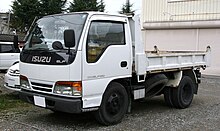 Elf 250, pre-facelift model
Elf 250, pre-facelift modelThe fifth generation Isuzu Elf appeared in July 1993, with more sculpted headlights. The 2.8 4JB1 and 4JB1T are standard on both Elf 150 10 ft/14 ft. and Elf 250 along with 3.6 4BE1. The non turbo 4JB1 features a new VE Rotary injection pump which increase power to 90ps and euro emission. In May 1995 it received a minor change, including upgraded, cleaner diesel engines. The H-series 4.0-liter 4HE1 and 4.3-liter 4HF1. The 16 ft. Chassis with H-series engine are standard while the 14 ft. Version are still in production. OEM deal with Nissan led to the Elf also being sold badged as a Nissan Atlas and a Nissan Diesel Condor 20/30/35 beginning at this time, followed by the Nissan Atlas Max from 1996 until 2000. The Atlas Max was based on the new, lighter duty Elf 100 (June 1995) which was available with a 2-liter petrol or a 2.5 or 2.7-liter diesel engine.[20]
In the U.S. the Elf was marketed as the Isuzu NPR and Chevrolet/GMC W series, each available with either the 4HE1 4.8-liter turbocharged diesel engine or GM’s L31 Vortec 5.7-liter gas engine and 4L80-E Automatic Transmission. The gas engine produced 275 hp (205 kW) to 325 hp (242 kW) at 4600 rpm and 330 lb·ft (447 N·m) to 350 lb·ft (475 N·m) of torque at 2800 rpm.
In May 2004, subsequent to a few minor changes, the Elf underwent a more major facelifts with new, larger, trapezoidal headlamps. Another OEM deal was forged at this time and the Elf was now also marketed as a Mazda Titan in parallel.
In Malaysia, this truck is manufactured by Heavy Industries Corporation of Malaysia (Isuzu HICOM Malaysia) under the name of HICOM Perkasa, but carrying the Isuzu N-Series Commando badge.
Sixth generation[edit]
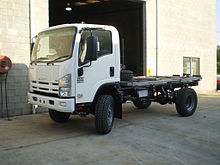
The sixth generation Elf/N series was released in December 2006 (High Cab and Wide Cab) and February 2007 (Regular Cab). By the time the full range was available, the fifth generation Elf was retired. This was also assembled in Colombia (alongside the heavier F series), where it was sold as the Chevrolet NKR, NPR, or NQR. GM began assembling Isuzu trucks in Chile in 1984.[23] The headlight-turnsignal cluster is now configured in the shape of the Isuzu «twin bar» logo, which was used from 1974-1991. In North America, GM sold the Isuzu N series as the Chevrolet and GMC W series until 2009. In 2016, it reintroduced the model as the Low Cab Forward (LCF) series, named simply the Chevrolet 3500, 4500, or 5500, and available with the same gasoline or diesel engines.[24]
The design of the 6th-generation Isuzu Elf cabin bears some resemblance to an all-fiberglass cabin fitted to trucks made by the Brazilian company Agrale since 2003. Agrale introduced an all-steel Chinese copy of the Isuzu wide cab to its truck range in late 2015, but the fiberglass cab was not phased out.
Nomenclature[edit]
The Elf is sold as an Elf in some markets aside from the domestic Japanese, such as Mexico and Indonesia, but in most export markets it is called the Isuzu N series. The second letter denotes weight rating, with H and K being used for the regular cab, M for the High Cab, and P, Q, and R for the Wide Cab model. The third letter denotes drivetrain layout; here an R means rear-wheel drive while S signifies four-wheel drive.
See also[edit]
References[edit]
- ^ [1] Archived January 7, 2010, at the Wayback Machine
- ^ «AF Trucks». www.facebook.com. Retrieved 2019-12-26.
- ^ LEUTE, JAMES P. «Thursday is last day of production as Isuzu line comes to end». gazettextra.com.
- ^ «Isuzu deslocaliza produção de Vendas Novas para Itália». Transportes & Negócios (in Portuguese). 2014-02-13. Retrieved 2019-12-26.
- ^ Ozeki, Kazuo (2007). 日本のトラック・バス 1918~1972 [Japanese Trucks and Buses 1918-1972] (in Japanese). Tokyo: Miki Press. p. 68. ISBN 978-4-89522-494-9.
- ^ Ozeki, p. 52
- ^ Ozeki, p. 53
- ^ Nagayama, Koji (永山 浩二) (2009), いすゞ『エルフ』 50年史 [50 years of the Isuzu «Elf»] (PDF) (in Japanese), Society of Automotive Engineers of Japan (JSAE), p. 1
- ^ Ishikawa, p. 75
- ^ Ozeki, p. 55
- ^ Ozeki, pp. 64-65
- ^ a b c Ishikawa, p. 68
- ^ «いすゞTLシリーズ マイクロバスの系譜 (いすゞ編_1)» [Genealogy of Isuzu TL series microbus (Isuzu first edition)] (in Japanese). 403 Forbidden. Retrieved 2014-01-12.
- ^ a b c d Nagayama, p. 2
- ^ a b 自動車ガイドブック [Japanese Motor Vehicles Guide Book] (in Japanese). Japan: Japan Automobile Manufacturers Association. 25: 131. 1978-10-10. 0053-780025-3400.
- ^ Ishikawa, p. 77
- ^ Meyer, Donald E. (March 2009), «The first century of GMC truck history» (PDF), GM Heritage Center, General Motors, p. 38
- ^ Meyer, p. 39
- ^ a b Ishikawa, p. 71
- ^ a b Ishikawa, p. 72
- ^ «Beijing LAC Китай» [Beijing LAC (China)]. Книги и Каталоги (Books and Catalogues) (in Russian). За рулем. Archived from the original on 2011-08-19.
- ^ 牛汉华 (Niu Han Hua) (2012-03-29). 高效城市物流 8款高端蓝牌轻卡车型推荐 [Eight efficient urban logistics blue-plate truck recommendations]. 卡车之家 [House of Trucks] (in Chinese).
- ^ «Chevrolet alcanza el récord de 20.000 camiones armados en Chile» [Chevrolet reaches record 20,000th truck assembled in Chile] (in Spanish). General Motors. 2008-06-19. Archived from the original on 2009-02-14.
- ^ http://www.autonews.com/article/20150615/OEM01/150619921/gm-returns-to-medium-duty-truck-market-partners-with-isuzu
Works Cited[edit]
- Ishikawa, Kenji (2012-05-01), «トラックメーカーアーカイブ: いすゞ自動車のすべて [Truck Manufacturer Archive: Everything Isuzu]», Camion (in Japanese), Tokyo, Japan: Geibun Mooks, ISBN 978-4-86396-183-8
External links[edit]
 | Wikimedia Commons has media related to Isuzu Elf. |
en.wikipedia.org
Isuzu Elf — технические характеристики, полное описание
Компактные грузовики линейного ряда Isuzu Elf – это простые среднегабаритные автомобили, которые начали производить еще в 1959 году. Производился он под лаконичным названием TL или N серия. Самая старая автомобильная компания в Японии многое поставила на производство грузовых авто и серия «Эльф» стала весьма успешной в плане продаж и водительских предпочтений.
История создания модельного ряда
Первоначальная модель Исудзу Elf весила две тонны, была оснащена бензиновым двигателем объемом 1,5 л и имела под капотом 60 л. с. Далее появилась Исузу Эльф 150 и 250 с соответствующей названию грузоподъёмностью (1,5 и 2,5 тонн). В 1970-ых появляются грузовики грузоподъемностью 3 и 3,5 тонн.
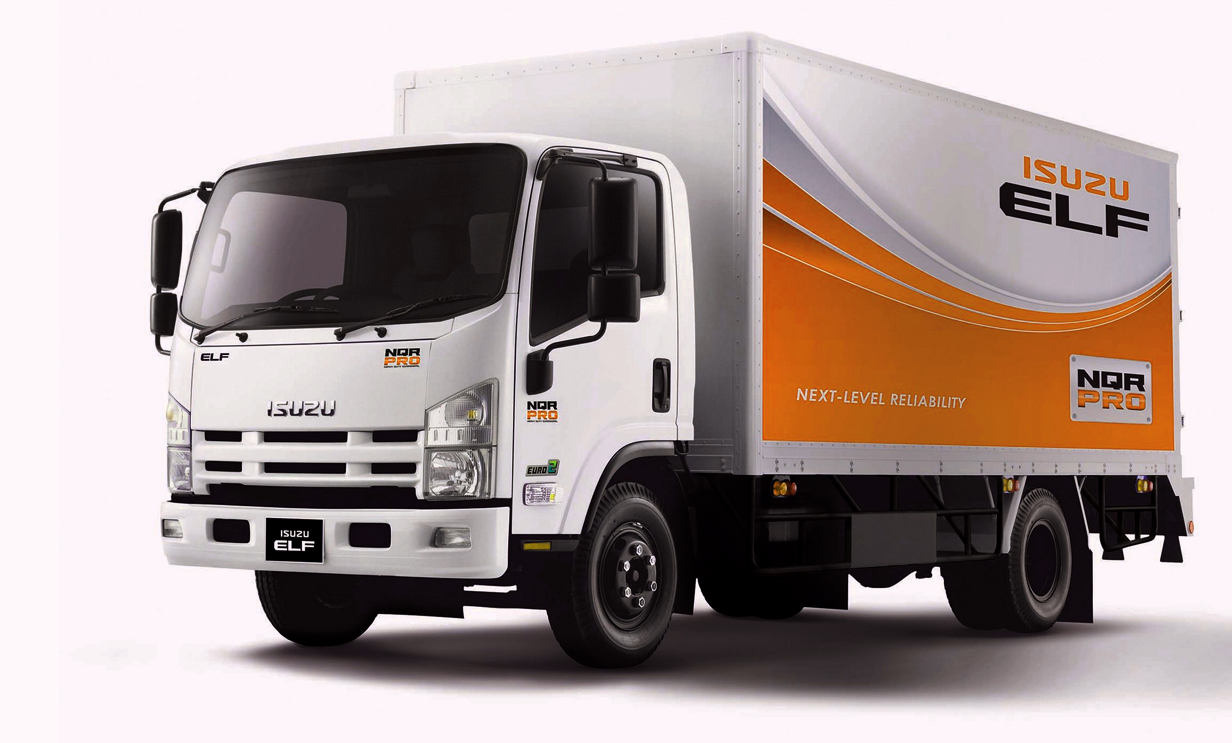
В тот период Исузу Эльф изготавливались и продавались не только на территории Японии. Союзные отношения с послевоенной Японией позволили наладить производство авто и в СССР. Также реализацию автомобилей наладили в Латинской Америке и Малайзии. В странах Латинской Америки авто изготавливали под брендом Chevrolet, однако обязательно указывалось и название самой компании. В Малайзии же модель приобрела название «HICOM Perkasa».
За первые три поколения Исузу Эльф изменилась очень много раз: то подтягивали мощность движка, то увеличивали его объем, изменяли конструкцию и вид корпуса и т. д. С начала же 90-ых годов модель приобрела до сих пор характерные черты, которые выделяют ее на фоне других. В 1998 году на рынок поставили авто, работающие на газу. Далее же изменение носили скорее косметический характер.
Технические характеристики
Японский грузовик имеет множество модификаций в шести поколениях, да и к тому же компания предоставляет специализированный транспорт этого модельного ряда. Они отличаются по виду кабины, типу шасси и грузоподъемности. Среди них можно выделить Isuzu Elf версии:
- 3.5 — малотоннажники грузоподъемностью до 1,4 тонны и допустимой полной массой до 3,5 тонн. Компактная модель, оснащенная турбодизельным мотором мощностью до 124 л.с. Рама лонжеронного типа позволяет устанавливать различные виды кузова.
- 5,5 — относится к среднетоннажным моделям, которые отличает выносливость и экономичный двигатель. Предназначена для городских перевозок. Грузоподъемность — 3,4 т
- 5,2 — среднегабаритный грузовик, который может перевозить грузы до 3,1 тонны. Платформа с усиленной рамой обладает повышенной прочностью.
- 7,5 — маневренный и удобный грузовик с оптимальными параметрами для перевозок в городских условиях. Шасси позволяет приспособить авто для своих нужд.
- 9,5 — для перевозки грузов до 6,5 тонн. Оснащено тормозной системой пневматического типа. Можно использовать в составе автопоезда с прицепом до 3,5 тонн. В зависимости от модификации двигатель достигает мощности 190 л.с. Классическое шасси предназначено для монтажа необходимых надстроек от бортового грузовика до пожарной цистерны.
-

- Спецтехника
-

- Бортовой автомобиль
-

- Промтоварный фургон
-

- Изотермический фургон
Далее более подробно рассмотрим параметры трех представителей модельного ряда.
| DRY VAN 2T ALUMINUM COLGATE PANEL | DUALMODE MT WIDE CAB HIGH FLOOR | HYBRID Smoother-E Flat Low, Long Body Dry Van | |
| Год выпуска | 1997 | 2002 | 2005 |
| Кузов | KC-NKR66EAV-6EX | KR-NPR81PR-5JXA | VD-NPR81AN-L6EX-H |
| Объем двигателя (см. куб.) | 4334 | 4777 | 4777 |
| Модель двигателя | 4HF1 (дизельный) | 4HL1 (дизельный) | 4HL1-HE11 (бензин) |
| Мощность (л. с.) | 130 | 140 | 130 |
| Габариты д\ш\в (мм) | 4950\1890\2940 | 6750\2180\2210 | 6410\2195\3165 |
| База (мм) | 2490 | 3815 | 3365 |
| Клиренс (мм) | 155 | 190 | 185 |
| Снаряженная масса (т) | 2,51 | 2,9 | 3,48 |
| Количество мест | 2 | 3 | 3 |
| Полная масса (т) | 4,62 | 6,065 | 5,645 |
| Шины | 195\70R15.5 | 205\85R16 | 225\70R16 |
| Крутящим момент (кг*м\об. мин.) | 31.0\1800 | 33.9\1500 | 34.0\1500 |
Описание Isuzu Elf 7.5
На данный момент эта версия является наиболее востребованной. Автомобиль выпускается в четырех комплектациях, от которых зависит силовая установка и набор опций для кабины. Для Elf 7.5 предусмотрено два двигателя «4НК1». Покупатель может выбрать с Euro-4 или Euro-5. Максимальная мощность силовой установки составляет 155 л.с. Оба варианта работают в паре с 6-ступенчатой механикой. В зависимости от комплектации, грузоподъемность составляет 4780, 4740, 4725 или 4715 кг.
Автомобиль прошел специальную адаптацию к российским дорогам. Это включает в себя дополнительную защиту от коррозии, утепление кабины и усиление подвески. Это скорее послужило причиной популярности данной модификации у водителей из России.
Салон отличается простотой и комфортностью. Все функции под рукой, сиденье и руль удобно регулируются. Имеется достаточно свободного пространства между сиденьями вокруг.
-

- Характеристики Elf 7.5
Заключение
Японцы в результате стали единственными, кто смог сделать действительно хорошие авто, грузоподъёмностью до 6,5 тонн. Модель отличается выносливостью, хорошей маневренностью, высокой грузоподъемностью и доступной ценой.
В минусы данной линейки можно вынести разве что не самый комфортабельный салон, так как машина рассчитана скорее на рабочие цели и недалекие перевозки.
Кроме того, isuzu elf сложно назвать идеальной в плане управления. Она рассчитана не для наших дорожных условий. Хотя зачастую приспособить Эльфа к русским дорогам можно, да и клиренс Исузу Эльф позволяет, все же управление не самое мягкое.
Сомнения вызывают и авто с пробегом по России. Как показывает практика, автомобили с рук зачастую очень ненадежные из-за неправильного обслуживания.
naperevoz.ru
|
Модель шасси (коммерческое наименование) |
ISUZU ELF 9.5 | |||
|
Модель шасси (сертификационное наименование) |
ISUZU ELF 9.5 SHORT (ISUZU NQR90L-H) |
ISUZU ELF 9.5 NORMAL (ISUZU NQR90L-K) |
ISUZU ELF 9.5 LONG (ISUZU NQR90L-L) |
ISUZU ELF 9.5 EXTRALONG (ISUZU NQR90L-M) |
|
Массогабаритные характеристики | ||||
|
Длина х Ширина х Высота, мм |
6040 х 2130 х 2275 |
6690 х 2115 х 2265 |
7410 х 2115 х 2265 |
7870 х 2115 х 2265 |
|
Колесная база, мм |
3365 |
3815 |
4175 |
4475 |
|
Минимальный дорожный просвет, мм |
210 |
210 |
210 |
210 |
|
Колея передних / задних колес, мм |
1680 / 1650 |
1680 / 1650 |
1680 / 1650 |
1680 / 1650 |
|
Полная масса автомобиля, кг |
9500 |
9500 |
9500 |
9500 |
|
Полная масса автопоезда, кг |
13000 |
13000 |
13000 |
13000 |
|
Снаряженная масса шасси, кг |
2905 |
2905 |
2930 |
2950 |
|
Грузоподъемность шасси, кг |
6595 |
6595 |
6570 |
6550 |
|
Кабина |
Однорядная, 3-местная, без спального места. Обновленный дизайн |
|||
|
Силовой агрегат | ||||
|
Модель |
ISUZU 4HK1 (4HK1E5CC) |
|||
|
Экологический класс |
Евро-5 |
|||
|
Количество / расположение цилиндров |
4 / рядное |
|||
|
Тип ГРМ |
SOHC, 16-клапанный |
|||
|
Рабочий объем двигателя, см3 |
5193 |
|||
|
Мощность, кВт / л.с. при об/мин |
140 / 190 при 2600 |
|||
|
Крутящий момент, Н*м при об/мин |
513 при 1600-2600 |
|||
|
Сцепление |
Сухое, однодисковое |
|||
|
Модель коробки передач |
ISUZU MZZ6F |
|||
|
Тип коробки передач |
6-ступенчатая, механическая |
|||
|
Привод / ведущие колеса |
4х2 / задние |
|||
|
Раздаточная коробка |
Отсутствует |
|||
|
Основные характеристики шасси | ||||
|
Тормозная система |
Пневматическая с ESC (включает ABS и ASR) |
|||
|
Тормозные механизмы передние / задние |
Барабанные / Барабанные |
|||
|
Подвеска передняя / задняя |
Рессорная / рессорная |
|||
|
Допустимая нагрузка на переднюю ось, кг |
3100 |
|||
|
Допустимая нагрузка на задний мост, кг |
6400 |
|||
|
Расстояние между лонжеронами рамы, мм |
850 |
|||
|
Размеры лонжерона рамы, мм |
216 х 70 (толщина 6 мм) |
|||
|
Размерность шин |
225/75R17.5 |
215/75R17.5 |
||
|
Емкость топливного бака, л |
140 |
|||
|
Стартер |
24В-4,5кВт |
|||
|
Генератор |
24В-80А |
|||
|
Стандартная комплектация и возможные опции | ||||
|
Подогрев зеркал заднего вида |
+ |
|||
|
Электрорегулировка зеркал заднего вида |
— |
|||
|
Моторный тормоз-замедлитель («горный тормоз») |
+ |
|||
|
Основной топливный фильтр с подогреваемым влагоотделителем |
+ |
|||
|
Фильтр предварительной очистки топлива |
+ |
|||
|
Рулевая колонка с регулировкой наклона и вылета |
+ |
|||
|
Аудиоподготовка + Антенна |
+ |
|||
|
Зуммер заднего хода |
+ |
|||
|
Дневные ходовые огни |
+ |
|||
|
Противотуманные фары |
+ |
|||
|
Складные рычаги стояночного тормоза и КП |
— |
|||
|
Солнцезащитный козырек для водителя и пассажира |
+ |
|||
|
Полки в кабине над головами водителя и крайнего пассажира |
+ |
|||
|
Стеклоочистители с регулируемой частотой работы |
+ |
|||
|
Тканевая обивка сидений |
+ |
|||
|
Полная обшивка интерьера кабины |
+ |
|||
|
Окрашенный в цвет кабины передний бампер и решетка радиатора |
+ |
|||
|
Угол открывания дверей кабины 90 град |
+ |
|||
|
Стабилизатор поперечной устойчивости передней оси |
+ |
|||
|
Стабилизатор поперечной устойчивости задней оси |
— |
|||
|
УВЭОС «ЭРА-ГЛОНАСС» |
+ |
|||
|
Кондиционер с ручным управлением |
+ |
|||
|
Электрические стеклоподъемники |
+ |
|||
|
Центральный замок |
+ |
|||
www.isuzu.ru
ELF 3.5 4×4 Шасси ISUZU
Наличие полного привода в условиях российских дорог является неоспоримым преимуществом любого автомобиля. Шасси ISUZU ELF 3.5 – самое легкое в модельном ряду ISUZU. Оно имеет небольшие габариты, что значительно упрощает процесс парковки и маневрирования в плотном потоке машин.
Характеристики шасси ELF 3.5 с полным приводом 4х4 от ISUZU
ISUZU ELF 3.5 4х4 – отличный автомобиль для бизнеса, имеет высокую производительность, но при этом обладает экономичным расходом топлива. Долговечность и надежность также находятся на высоком уровне.
Все грузовики ISUZU нового поколения имеют кабины кубической формы. Концепция «цельность, чистота и выразительность» исключает ненужные линии, грани и конструктивные элементы. Все предельно функционально и эффективно. Аэродинамическая форма передних углов крыши сокращает сопротивление воздуха, что способствует дополнительной экономии топлива.
Важное преимущество грузовика ELF 3.5 4х4 – достижение конструкторами ISUZU экологического класса двигателя Евро-5 без применения сажевого фильтра и мочевины. Это повышает экологичность автомобиля и не вредит его техническим характеристикам, вам не потребуется постоянно менять фильтра и тратить дополнительные средства на обслуживание.
Отличительной особенностью Исузу Эльф 3.5 является возможность управления ТС с правами категории «В».
«Исузу» ELF 3.5 4х4 от официального дилера
Как официальный представитель ISUZU в России мы предлагаем Вам максимально выгодные условия покупки автомобиля и гарантируем качество каждого грузовика и его комплектующих. Мы уверены в своем продукте и на все грузовики ISUZU даем гарантию в 3 года или 200 000 км пробега. Обращайтесь к официальным дилерам ISUZU, чтобы купить авто ELF 3.5, получить консультацию или сделать расчет. Мы можем предложить вам самый большой спектр полнокомплектных автомобилей за счет наличия у шасси ISUZU универсальной рамы, на которую можно установить практически любую надстройку.
www.isuzu.ru

